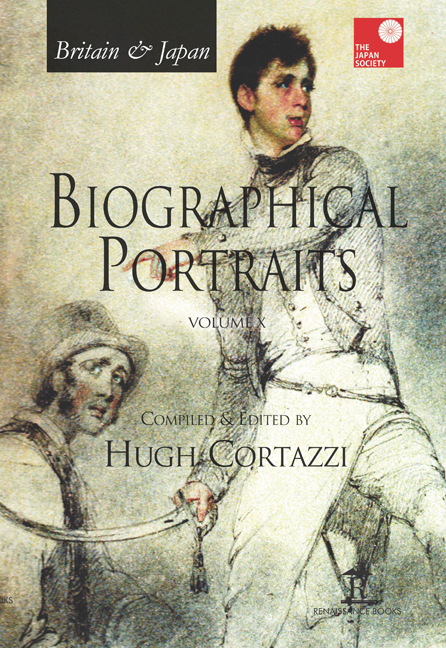Book contents
- Frontmatter
- Dedication
- Contents
- Introduction
- List of Contributors
- Index of Biographical Portraits in Japan Society Volumes
- PART I BRITAIN IN JAPAN
- PART II JAPAN IN BRITAIN
- Select Bibliography of Works in English on Anglo-Japanese Relations [Compiled by Gill Goddard – Retired East Asian Studies Librarian, University of Sheffield]
- Select Bibliography of Works in Japanese on Anglo-Japanese Relations [Compiled by Akira Hirano, SISJAC]
- Index
59 - Nakaya Ukichiro (1900–1962): Snow Scientist
Published online by Cambridge University Press: 07 May 2022
- Frontmatter
- Dedication
- Contents
- Introduction
- List of Contributors
- Index of Biographical Portraits in Japan Society Volumes
- PART I BRITAIN IN JAPAN
- PART II JAPAN IN BRITAIN
- Select Bibliography of Works in English on Anglo-Japanese Relations [Compiled by Gill Goddard – Retired East Asian Studies Librarian, University of Sheffield]
- Select Bibliography of Works in Japanese on Anglo-Japanese Relations [Compiled by Akira Hirano, SISJAC]
- Index
Summary
INTRODUCTION
‘Yuki wa ten kara okurareta tegami de aru’
(Each snow crystal is a letter sent from heaven)
NAKAYA UKICHIRO IS well known as a snow scientist specialising in low-temperature sciences. He succeeded in creating the world’s first artificial snow crystals, and a museum is dedicated to him in his home town of Kaga in Ishikawa prefecture, Japan. However, little is known of his time at Kings College London, from 1928 to 1929. This account based on his unpublished diaries and published essays, shows how the enduring relationships he made and his holistic approach to research established him as a pioneering and experimental international scientist and artist, with qualities of compassion and understanding of other cultures and the natural world.
Nakaya Ukichiro was born on 4 July 1900. As a physicist, he was unique in that he had both an artistic and scientific sensibility and was one of the earliest environmentalists, noting the effects of humanity on the natural wildernesses especially in the Polar Regions. Nakaya was inspired to study physics, which at that time included astronomy, at high school. However Nakaya had first trained at an early age as an apprentice to a potter and his first scientific paper in 1924, for Tokyo Imperial University Physics Department was actually on Kutani porcelain. In 1925, he graduated in experimental physics under the guidance of Terada Torahiko at Tokyo Imperial University and after graduation became Terada's research assistant at RIKEN (Institute of Physical and Chemical Research) working on electrostatic discharge.
IN LONDON
For a brief period from 1928 to 1929, Nakaya travelled to London to take up research at Kings College London, leaving Aya-san, his new wife of three months, at a time when there were no opportunities to make a quick dash home and when a requirement for an unwavering commitment to the unknown was required.
Nakaya's adviser Terada, was an accomplished painter and writer of scientific essays and had studied under the famous Japanese writer Natsume Sōseki. Natsume had spent two years at University College, London, from 1901 to 1903. Terada was a model for many of Natsume's characters in his novels and had also visited London in 1911. Even though, by all accounts, Natsume did not enjoy London, he may have in some way influenced Nakaya's decision to choose Britain rather than France or Germany, the popular destinations for a Japanese scientist at that time.
- Type
- Chapter
- Information
- Britain & Japan Biographical Portraits Vol X , pp. 663 - 679Publisher: Amsterdam University PressPrint publication year: 2016

